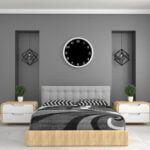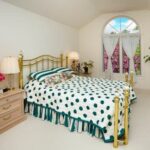English home style decoration exudes timeless charm and elegance, bringing a sense of warmth and sophistication to any space. With its rich history and influences, this classic design aesthetic has stood the test of time, captivating homeowners around the world. In this article, we delve into the origins of English home style decoration, unraveling its fascinating history and exploring its key elements.
From stately manor houses to cozy cottages, English home style decoration is deeply rooted in tradition and heritage. It draws inspiration from various architectural styles including Georgian, Victorian, and Edwardian, resulting in a unique blend of grandeur and comfort. By understanding the origins of this decorative style, we gain insights into its evolution over the centuries and the cultural influences that have shaped it.
Beyond architectural features, English home style decoration embraces a carefully curated selection of colors, textures, and fabrics. Neutral palettes combined with rich accents create a sense of harmony and serenity. Intricate patterns and luxurious textiles add depth and character to each room. By uncovering these design elements, we gain an appreciation for their role in creating the distinctive ambiance associated with English home style decoration.
Furnishing plays a crucial role in achieving the quintessential English home look. Antique furniture pieces are often chosen for their craftsmanship and timeless appeal. Traditional styles like Queen Anne or Chippendale add a touch of elegance while providing practicality. These furnishings bring together formality with comfortable living spaces to create an inviting atmosphere that stands true to English home style decoration.
As we embark on this journey through the world of English home style decoration, we discover how lighting plays a vital role in setting the mood. Soft ambient lighting enhances the warm hues and showcases intricate details within the room’s interior architecture. Natural light is also valued greatly – large windows allow for abundant daylight which adds vibrance to every space.
By embracing textiles and patterns that exude luxury yet retain simplicity, the beauty of English home style decoration really shines. From sumptuous curtains and upholstery to carefully chosen wallpapers, elegant fabrics elevate the overall aesthetic. Adding floral or delicate patterns brings in a touch of English romanticism that is timeless and engaging.
Accessorizing an English home is a way to further enhance its character and authenticity. Decorative objects like intricate china, antique clocks, and elegant candelabras add personality to the space while reflecting its traditional roots. Artwork also plays a significant role in showcasing the homeowner’s tastes and cultural affinities.
Creating a cohesive English home style decoration requires balance and harmony in every aspect of design. By thoughtfully combining architectural features, colors, furnishings, lighting, textiles, patterns, and accessories, homeowners can create a space that encapsulates the inviting charm of English interiors.
The Origins of English Home Style Decoration
English home style decoration has a rich and fascinating history that has shaped its distinctive aesthetic. To fully appreciate the charm of this timeless decorating style, it is essential to understand its origins and influences.
The roots of English home style decoration can be traced back to several key influences. One significant influence is the Tudor era, which spanned from the late 15th century to the early 17th century. During this time, Tudor architecture and design principles emerged, characterized by features such as timber framing, intricate stone carvings, and leaded glass windows. These architectural elements continue to be prevalent in English home style decoration today.
Another influential period in English home style decoration was the Georgian era, which extended from the early 18th century to the early 19th century. The Georgian period was known for its classical architecture and elegant interiors. Homes were adorned with neoclassical elements such as grand moldings, symmetrical layouts, and classical motifs. This emphasis on balance, proportion, and refined details continues to shape the aesthetic of English home style decoration.
In addition to these historical influences, English home style decoration also draws inspiration from natural surroundings. The lush landscapes of the English countryside have long been an inspiration for interior design. Nature-inspired motifs such as floral patterns and botanical prints are commonly found in fabrics and wallpapers used in English homes. Furthermore, colors often mirror those found in nature, with soft pastels like sage green or dusty blue frequently used alongside rich earth tones.
Understanding the historical context and diverse influences of English home style decoration allows homeowners to embrace this aesthetic with more depth and authenticity. By combining architectural features from different periods and incorporating natural elements into their design choices, individuals can create a truly timeless look that exudes classic elegance.
| Key Influences | Characteristics |
|---|---|
| Tudor Era | – Timber framing
|
| Georgian Era | – Classical architecture
|
| Nature | – Floral patterns and botanical prints
|
Key Elements of English Home Style Decoration
The key elements of English home style decoration encompass a variety of architectural features and design elements that contribute to its timeless charm. One significant architectural feature commonly found in English homes is the use of timber framing, also known as half-timbering. This technique involves exposing the wooden framework on the exterior walls, creating a distinct aesthetic that is both rustic and elegant.
Another architectural feature prevalent in English home style decoration is the presence of large fireplaces. These fireplaces serve both functional and decorative purposes, providing warmth during colder months while also adding character to the space. Many English homes also feature intricate plasterwork or molding on the ceilings and walls, showcasing exquisite craftsmanship and attention to detail.
In terms of design elements, English home style decoration often incorporates traditional patterns such as florals, stripes, and plaids. These patterns can be found in upholstery fabrics, curtains, wallpapers, and even carpets or rugs. Additionally, English homes tend to showcase a mix of antique and traditional furniture pieces that contribute to a classic look. Fine craftsmanship, rich wood finishes, and intricate details are characteristics often seen in these furniture pieces.
To complement the architectural features and design elements, English home style decoration favors a color palette that evokes warmth and coziness. Traditional colors such as deep reds, dark greens, warm browns, and creamy whites are frequently used. These colors not only create a welcoming atmosphere but also provide a sense of richness and depth to the space.
Overall, understanding the key elements of English home style decoration is crucial for creating an authentic aesthetic. By incorporating timber framing, large fireplaces, intricate plasterwork/molding, traditional patterns, antique/traditional furniture pieces, and a warm color palette into your home décor scheme; you can achieve an exquisite look that exudes elegance and timelessness.
Colors and Textures
The palette of colors and textures plays a crucial role in capturing the essence of English home style decoration. This design aesthetic draws inspiration from the beautiful countryside landscapes, historic architecture, and the opulence of British history. By incorporating specific colors and textures, you can create a warm and inviting atmosphere that reflects the timeless charm of English homes.
One key aspect of English home style decoration is the use of earthy and natural tones. These colors help to establish a connection with nature and evoke a sense of tranquility. Shades such as soft greens, warm browns, muted blues, and creamy whites are commonly used in this decor style. These hues can be applied to walls, furniture upholstery, window treatments, and other decorative elements to enhance the overall ambience.
In addition to color, textures also play a vital role in English home style decoration. The use of textures adds depth and visual interest to the space while maintaining a cozy feel. Incorporating materials like wood, stone, wicker, linen, and velvet can create a tactile experience that further enhances the overall aesthetic. For example, exposed wooden beams on ceilings or rustic brick walls add a touch of warmth and character to the room.
When using different textures in English home style decoration, it’s important to strike a balance between them. Too many contrasting textures can create visual chaos while too few may make the space feel flat or boring.
A mixture of rough and smooth surfaces is often employed to achieve harmony within the decor scheme. Consider combining textured wallpaper with smooth upholstered furniture or pairing rough-hewn wooden floors with soft plush rugs for an added layer of dimensionality within your space.
By carefully selecting colors that reflect nature’s beauty and incorporating complementary textures that add depth and richness to your decor scheme, you can successfully unveil the palette of English home style decoration. These elements work together harmoniously to create an inviting space that embodies the classic elegance and timeless charm associated with this beloved design aesthetic.
Furnishing the English Home
When it comes to achieving an authentic English home style decoration, furniture plays a crucial role in creating a classic look. Embracing antique and traditional furniture pieces is key to capturing the timeless charm of this aesthetic choice. Here are some key considerations when furnishing an English home.
- Antique Furniture: Antique furniture is a hallmark of English home style decoration. These pieces bring character and history into the space, showcasing craftsmanship from bygone eras. Look for vintage items such as Chippendale chairs, Victorian sofas, or Georgian tables to add an air of elegance and sophistication to your rooms.
- Traditional Pieces: Alongside antique furniture, incorporating traditional pieces can enhance the classic appeal of an English home. Opt for upholstered armchairs with intricate detailing or wingback chairs for a touch of grandeur. Oak or walnut wood finishes are also popular choices that exude warmth and richness.
- Mixing Old and New: While antique and traditional furniture are the mainstay of an English home style, there’s room for incorporating more contemporary elements as well. Mixing old and new can create a dynamic contrast that adds depth to the decor. Consider pairing vintage chests with modern artwork or placing a sleek coffee table alongside a vintage sofa.
- Upholstery and Fabrics: The choice of upholstery fabrics can greatly influence the overall look and feel of an English home style decoration. Opt for luxurious materials like silk or velvet in rich tones such as deep burgundy or forest green to evoke elegance. Incorporating floral prints or plaids on cushions or curtains can also channel the quintessentially British aesthetic.
By embracing antique and traditional furniture pieces, you can create a truly classic look in your English home style decoration. Remember to mix old and new elements strategically while paying attention to upholstery choices that reflect the timeless charm of this aesthetic choice.
Enhancing the Ambience
In the world of interior design, lighting plays a crucial role in setting the mood and enhancing the ambiance of a space. This holds true for English Home Style Decoration as well, where lighting takes center stage in creating a warm and inviting atmosphere. Understanding the role of lighting is key to achieving the desired look and feel in an English home.
The Importance of Natural Light
In English Home Style Decoration, natural light is highly valued and often prioritized. Large windows are commonly used to allow ample natural light to flood into the space, creating a bright and airy atmosphere. Drawing inspiration from the English countryside, this style embraces the beauty of sunlight streaming through windows and casting its enchanting glow on the interiors. Therefore, when designing an English style home, it is important to consider window placement and size, ensuring that they maximize natural light.
Embracing Classic Lighting Fixtures
English Home Style Decoration often incorporates classic lighting fixtures that exude elegance and charm. Chandeliers, wall sconces, and table lamps are commonly found in these spaces, adding both functionality and beauty. Ornate chandeliers with crystal accents are frequently used as statement pieces in grand living rooms or dining areas.
Wall sconces provide soft ambient lighting and can be strategically placed to highlight architectural features such as fireplaces or bookshelves. Table lamps with fabric lampshades add a touch of sophistication to bedrooms or reading nooks. By selecting carefully crafted lighting fixtures, one can truly enhance the traditional aesthetic of an English home.
The Role of Task Lighting
While overall ambient lighting sets the tone for an English home’s decor scheme, task lighting serves a more functional purpose by providing focused illumination where needed. In areas such as kitchens or study rooms, task lighting plays a pivotal role in aiding specific activities such as cooking or reading. Pendant lights above kitchen islands or under-cabinet lighting can ensure proper visibility while working in the kitchen.
Similarly, adjustable desk lamps or floor lamps with adjustable heads are practical choices for study spaces. Incorporating well-placed task lighting not only adds functionality but also contributes to the overall cohesive design of an English home.
Textiles and Patterns
One of the key elements that make English home style decoration so timeless and elegant is the use of exquisite textiles and patterns. From luxurious drapery to intricate wallpapers, fabrics play a significant role in creating a warm and inviting atmosphere in an English home. The beauty lies in the attention to detail, with careful consideration given to colors, textures, and patterns that seamlessly blend together.
When it comes to textiles, English home style decoration incorporates a variety of materials, each adding its own unique touch. One popular choice is velvet, known for its lush feel and deep colors. Velvet upholstery on sofas or chairs instantly adds a touch of sophistication to any room. Additionally, damask fabrics are commonly used for curtains, cushions, or tablecloths due to their elegant woven designs.
Another important aspect of English home style decoration is the use of patterns. Floral prints are highly favored in this aesthetic as they add a sense of whimsy and romance. Delicate rose motifs or intricate paisley patterns can be found on upholstery, throw pillows, or even wallpaper. Furthermore, Toile de Jouy is an iconic pattern often seen in English country homes – showcasing idyllic scenes on fabric or wallpaper that transport you to the countryside.
To achieve a cohesive look, it’s essential to strike a balance between different fabrics and patterns throughout the space. Mixing delicate florals with larger-scale patterns can add interest and depth to a room while maintaining harmony. Additionally, incorporating solid-colored textiles can help ground the overall design while allowing patterned pieces to shine.
Accessorizing the English Home
When it comes to English home style decoration, accessorizing plays a crucial role in adding character and authenticity to the space. By carefully selecting and showcasing decorative objects and art, homeowners can truly bring their English-inspired interiors to life. Whether it’s through displaying cherished heirlooms or incorporating unique pieces collected over time, accessorizing allows individuals to tell their own personal stories within the context of this timeless aesthetic.
Embracing Traditional Decorative Objects
One way to infuse an English home with charm is by incorporating traditional decorative objects that are iconic to this style. Antique silverware, vintage china, and delicate porcelain figurines are just a few examples of accessories that can elevate the aesthetic of an English-inspired space. These pieces not only add elegance and sophistication but also evoke a sense of history and nostalgia.
In addition, decorative items such as ornate mirrors, antique clocks, and beautifully framed botanical prints can be used strategically throughout the home to enhance its character. By incorporating these traditional elements into the overall design scheme, homeowners can create a cohesive look that pays homage to the rich heritage of English interior design.
Artwork as Focal Points
Artwork plays a pivotal role in accessorizing an English home. Whether it’s classic oil paintings depicting landscapes or portraits, or contemporary art pieces with a nod to tradition, carefully chosen artwork can become focal points within any room. Large-scale paintings can act as statement pieces above mantels or headboards, while smaller works can be displayed on walls alongside family photographs or grouped together for a gallery wall effect.
The key lies in selecting art that resonates with the overall theme of the space while also reflecting personal taste. The beauty of accessorizing an English home is that there is room for individual expression alongside adherence to stylistic principles.
Curating Collections and Displaying Treasures
One of the joys of accessorizing an English home is the opportunity to display cherished treasures and curated collections. From vintage books and globes to antique ceramics and family heirlooms, these objects tell a story about the homeowners’ interests, travels, and personal history.
To showcase these pieces effectively, consider using bookshelves, display cabinets with glass doors, or even open shelves. By arranging items in an intentional manner – grouping similar objects together or curating a color-themed display – homeowners can create visual interest and add depth to their interiors.
Achieving Balance and Harmony
One of the key aspects of English home style decoration is achieving balance and harmony in every room. This design aesthetic is known for its timeless elegance, and creating a cohesive look throughout the entire home is essential. To achieve this, there are several tips and tricks that can be followed.
Firstly, it is important to consider the overall color scheme when decorating an English home. Traditionally, a neutral palette with soft hues such as creams, grays, and pastels is used to create a serene atmosphere. However, pops of color can be added through accessories or upholstery to add visual interest without overwhelming the space. It is crucial to ensure that the colors chosen complement each other and contribute to a harmonious overall look.
Another key factor in achieving balance and harmony in an English home style decoration is careful consideration of furniture placement. In order to create a cohesive look, furniture pieces should be arranged in a way that fosters conversation and allows for easy movement throughout the space.
Symmetry plays an important role in this design style, so using pairs of chairs or side tables can help create a sense of balance. It is also important not to overcrowd the room with furniture; instead, focus on selecting pieces that are both functional and aesthetically pleasing.
In addition to furniture placement, paying attention to scale and proportion is crucial when aiming for a cohesive look in an English home style decoration. Mixing different sizes of furniture can add visual interest but should be done with caution as too many different scales can disrupt the overall harmony. It is best to select pieces that are proportional to each other and fit well within the room’s dimensions.
By following these tips and tricks for achieving balance and harmony in an English home style decoration, you can create a cohesive aesthetic that exudes timeless charm. Remember to consider color schemes carefully, pay attention to furniture placement, and ensure that scale and proportion are taken into account. With these principles in mind, you can create a beautiful and inviting English home that showcases the elegance of this classic design style.
Final Thoughts
In conclusion, English home style decoration offers a timeless and inviting aesthetic choice for those who appreciate classic design and charm. Throughout this article, we have explored the rich history and influences behind English home style decoration, as well as the key elements that make it distinct. From the architectural features to the colors and textures, every aspect of English home style decoration exudes elegance and sophistication.
One of the defining characteristics of English home style decoration is its emphasis on traditional and antique furniture. By incorporating these pieces into your interior design, you can create a classic look that stands the test of time. Additionally, understanding the role of lighting is essential in enhancing the ambiance of an English-styled home. Soft and warm lighting creates a cozy atmosphere that complements the overall aesthetic.
Textiles and patterns play a crucial role in bringing out the beauty of English home style decoration. Elegant fabrics and prints add a touch of luxury and opulence to any space. Lastly, accessorizing with decorative objects and art adds character and authenticity to an English-styled home.
Overall, creating a cohesive English home style decoration requires careful attention to detail and a balance between all elements involved. By embracing this timeless aesthetic choice, you can transform your living space into a beautiful retreat that reflects elegance, warmth, and sophistication. So why not bring a touch of England into your own home?
Frequently Asked Questions
What is English style decor?
English style decor is an interior design aesthetic that captures the charm and elegance of traditional English homes. It is characterized by a timeless and classic look, often incorporating elements that reflect the country’s rich history and cultural heritage.
English style decor typically features a mix of antique furniture, floral patterns, fine china, and intricate details such as molding and trim work. This decor style exudes warmth, sophistication, and a sense of understated luxury.
How can I decorate my house English style?
To decorate your house in English style, there are several key elements to consider. Start by choosing a color palette inspired by nature, such as soft pastels or warm earth tones. Incorporate patterned wallpapers or upholstery in floral motifs for a quintessentially English touch.
Focus on selecting furniture pieces with traditional designs, like wingback chairs or Chesterfield sofas, and layer them with rich textures using throw pillows or blankets made from fabrics like velvet or chenille. Don’t forget to add antique accents and decorative items like brass candlesticks, porcelain vases or vintage artwork to enhance the overall English aesthetic.
What is English home decor?
English home decor reflects the characteristic features of houses found in England, encompassing various styles from different eras. It often showcases a blend of rustic elements alongside refined furnishings and accessories to create a harmonious balance between old-world charm and contemporary comforts. With its origins rooted in historical architecture and traditional craftsmanship, English home decor embraces elegance through attention to detail.
The use of natural materials like wood and stone is common in creating cozy living spaces while maintaining a certain level of sophistication throughout the home. Additionally, it places great importance on comfort by emphasizing soft furnishings like plush sofas, upholstered chairs, floor-to-ceiling curtains, and layered textiles that invite relaxation and warmth into every room.

I’m thrilled to be your companion on this exciting journey through the world of home decor and design. With a passion for turning houses into homes and a keen eye for the finer details, I’m here to help you transform your living spaces into beautiful, functional, and meaningful havens.





